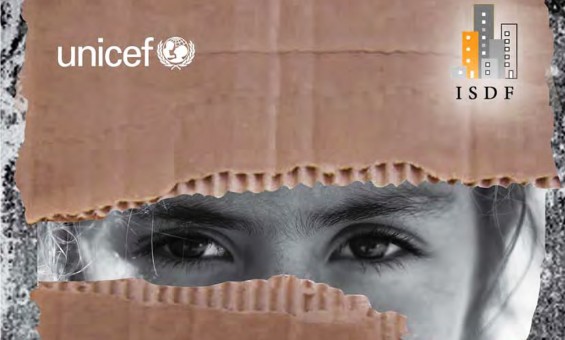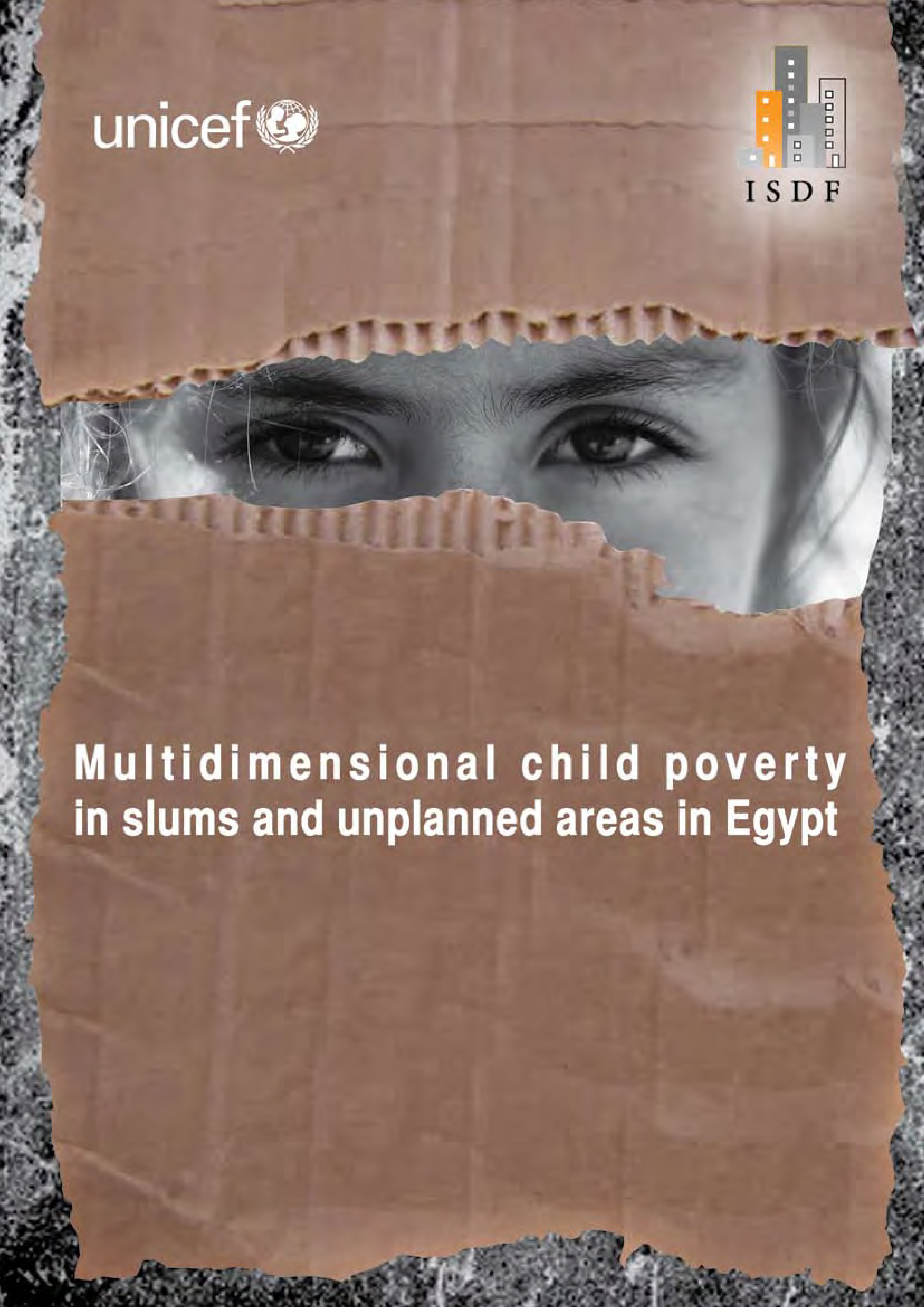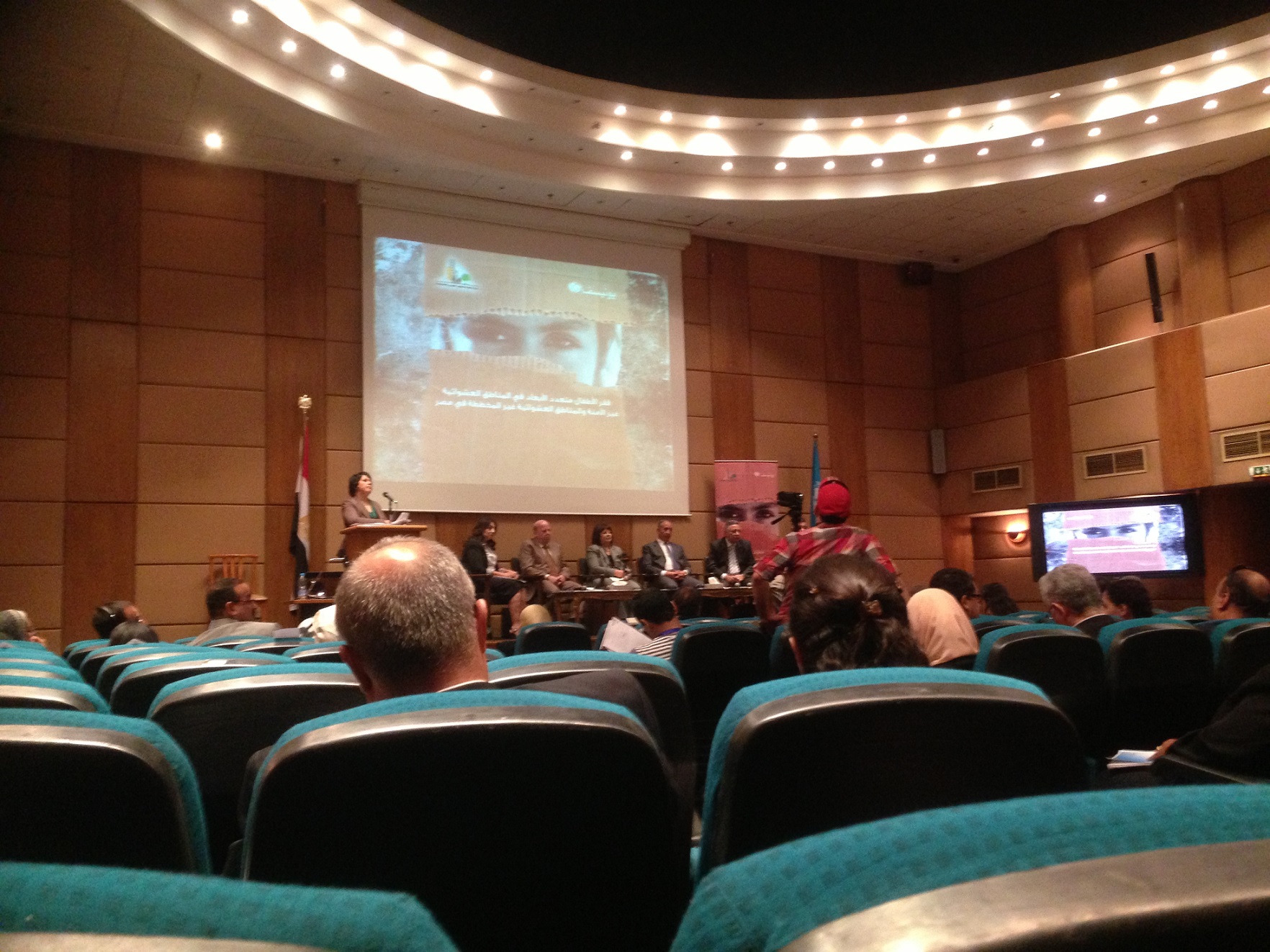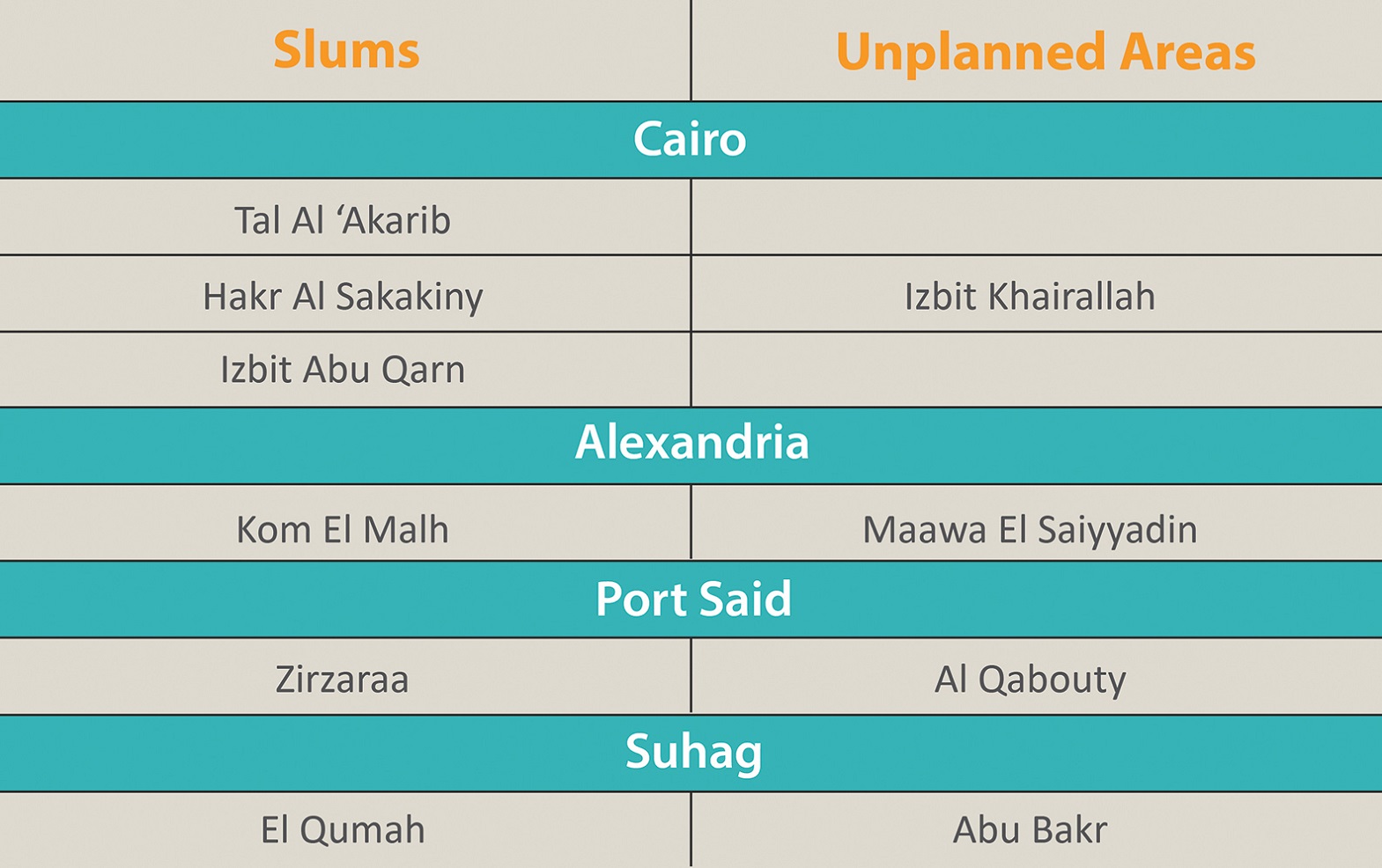
Publication Release| Multi-dimensional Child Poverty in Slums and Unplanned Areas in Egypt
On October 21, 2014 the Ministry of Urban Renewal and Informal Settlements (MURIS) convened a conference to release a study on child poverty in informal areas titled Multi-dimensional child poverty in slums and unplanned areas in Egypt. The study was jointly conducted by UNICEF and the Informal Settlements Development Facility (ISDF), which now falls under the jurisdiction of MURIS. The study release was timed to loosely coincide with the International Day for the Eradication of Poverty on October 17. MURIS invited government, civil society, and private sector representatives to share the study’s findings and engage them in a discussion about policies to combat child poverty in informal areas. This article provides an overview of the event as well as a review of the UNICEF-ISDF study.
The Publication Release Event
The event started with a brief introduction, followed by a screening of a UNICEF film about children in Tal al-‘Akārib, an area designated by the ISDF as an “unsafe area” located in the heart of the Sayidda Zaynab district.1 The short film compared the lives of children in Tal al-‘Akārib with that of a child living in Imbaba, an “unplanned” district in Giza, emphasizing that children’s living conditions are considerably poorer in Tal al-‘Akārib. After the clip screening, the UNICEF Representative in Egypt, Philippe Duamelle and the MURIS Minister Laila Iskandar, gave opening speeches. Duamelle stressed the need to rethink a common perception of rural areas being the primary locus of poverty, a perception challenged by the UNICEF-ISDF study:
When most of us think of a poor child, we picture a child in a rural area. We don’t imagine, as readily, a girl living in the shadow of a city school she will never attend, nor a family deprived of services enjoyed by those living only few streets away.
Iskandar stressed the need to be conscious of the poverty and inequality facing millions of children in our cities. Quoting oft-used media discourse on informal areas, she warned that informal areas will indeed become “bombs” and “hotbeds of crime” if we do not intervene. She also mentioned the need for a comprehensive child protection system and the importance of involving civil society organizations, particularly during policy implementation. The opening speeches were then followed by a presentation outlining the MURIS vision and strategy and another highlighting the key findings of the UNICEF-ISDF study, a review of which is below.
The conference also included a presentation from Major General Samih Qandil, Governor of Port Said. Qandil introduced the city of Port Said, its geography and its trade and then proceeded to present Mashru‘ Iskān Al-Amal Al-Jadid (The New Hope Housing Project), a joint project of the governorate and the ISDF in Zerzara, an area classified as “unsafe” by the ISDF (and covered by the study). Qandil presented the project as a success story, showing the audience a clip from a government-produced film, in which a woman ululates upon seeing her new flat for the first time. It is important to note that this account of events is selective. The inhabitants of Zerzara were forcibly evicted and several families remain homeless to this day.2 Throughout the presentation, Qandil made no mention of children.
Finally, the event concluded with a panel discussion and a controlled Q & A session. The UNICEF-ISDF study recommends an integrated policy approach that “link[s] together city housing policies and investment in social services and effective social protection” and so fittingly, the topic set for the panel discussion was “Integrated Policies Combating Child Poverty in Informal Areas” and the list of expected participants included ministers from concerned ministries (Health; Social Solidarity; Education; Local Development) as well as governors from cities covered by the study. Disappointingly, however, only a few of the listed ministers and governors were present to take part in the discussion and much of the talk revolved around youth unemployment, eco-friendly measures, housing projects and illegal water connections. In short, anything but the topic of the event: child poverty in informal areas.3 All throughout, Iskandar posed relevant questions to direct the discussion back to the topic but her efforts were to no avail. For the Q & A session, attendees were invited to submit questions in writing. This severely constrained the opportunity for spontaneous questions and an open debate; audience members with pertinent and controversial points struggled to voice their concerns.
All in all, the conference was disappointing. The study and its recommendations were hardly discussed and unfortunately, invited officials showed little interest in the issue of child poverty and little sensitivity to residents of informal areas. Port Said’s Governor Qandil described inhabitants of a particular informal area in his Governorate as being “ferocious” and the Red Sea’s Governor, Major General Aḥmad ‘Abdallāh, remarked that the source of our problems lies in behaviors and culture rather than resources, essentially blaming residents of informal areas for the problems they face and absolving government officials. Furthermore, the invited officials showed scant interest in engaging in much of a discussion, preferring instead to use the conference as a forum to recount their perceived achievements.
Review of the UNICEF-ISDF Study
The UNICEF-ISDF study Multi-dimensional child poverty in slums and unplanned areas in Egypt (2013) is part of a series of studies on child poverty, spearheaded by UNICEF. It aims to provide data on child poverty (ages 0-17) in urban areas that have been long-neglected in both planning and policy, specifically urban informal areas. Earlier studies had been broad in scope, encompassing both rural and urban areas in Egypt. Using the ISDF’s categorization of informal areas and information from a total of ten informal areas in Egypt, the study finds that children living in slums or “unsafe areas” are worse off than their counterparts in unplanned areas.4 41.5% of the children in unsafe areas experience monetary poverty, and 50 to 60% suffer from multi-dimensional poverty. Multi-dimensional poverty is defined as being severely deprived in at least two dimensions of well-being. According to the Bristol Approach, there are seven well-being dimensions against which child poverty can be measured: health, nutrition, water, sanitation, shelter, education, knowledge/information source.5 Each well-being dimension corresponds to articles laid out in the UN Convention on the Rights of the Child (CRC), which was adopted by the General Assembly in 1989 and ratified by Egypt in 1990.
The study makes a number of contributions particularly with regards to how child poverty in informal areas should be perceived and dealt with. In explaining the origins and development of informal areas, it acknowledges that informal areas have been more or less an “effective response” to the lack of successful housing policies over the past several decades, and presents a brief history of the development of informal areas in Egypt. An understanding of how these areas developed and the terms used to describe them especially in state and media discourse play an important role in shaping public attitudes towards these areas and justifying certain courses of action. The report refrained from using terms such as “crime hotbeds” and “Islamist hotbeds” that give an inaccurate picture of these areas and lead to a misunderstanding of the problems faced in such areas. Such sensationalist terms also lead to the “othering” of their residents. Conversely, an objective, historical understanding of the phenomenon shows that, contrary to long-standing narratives and opinions, residents of informal areas are not “ferocious” law-breakers who seized state-owned land in the presence of lawful alternatives and deliberately created eyesores around the city. Needing shelter and with no affordable housing options in sight, they had limited other solutions to their predicament. The study’s narrative of the development of informal areas is complemented by its right-based approach. It makes clear that children have rights; that poverty constitutes a violation of their rights; and that it is urgent that poverty-affected children are given their due rights.
In choosing to focus on children, in particular, and using non-monetary indicators (as well as more traditional monetary indicators) to analyze poverty, the study helps build a better understanding of the issue. The impact of poverty on children differs from adults, in terms of intensity and persistence, hence the need for group-specific analysis and policy. Moreover, monetary measures such as household income and consumption levels are insufficient by themselves to provide a full and accurate picture of the issue, in all its complexity. Insufficient income is not the only manifestation of child poverty, nor does its sufficiency embody the solve-it-all solution. Child poverty is, as the study posits, a multi-dimensional phenomenon, which manifests itself in different areas including housing and health, and calls for a combination of different interventions.
The study also rightly identifies a general lack of data for informal areas and the need to rectify this information gap, which is partially behind many of the misconceptions surrounding informal areas and the invisibility of their inhabitants in planning and policy. Furthermore, in selecting informal areas in four different cities (Cairo, Alexandria, Port Said, and Sohag), the study succeeds in providing a national picture of the situation.
That being said, the study comes short of being a useful resource. To collect data, the study used a household survey and a community survey. These surveys mainly sought to extract quantifiable information but were also interested (albeit to a slightly lesser degree) in qualitative information such as perceptions of poverty and attitudes towards female genital mutilation. The published study primarily provides the reader with a number of statistics and charts, showing the availability of indicators such as education facilities in the respective areas, the percentage of households with a water connection, and immunization rates. The type of information provided, though it fills a critical knowledge gap, does not present a complete and sufficiently nuanced picture of child poverty in informal areas. The inadequacy of the information presented in this study stems from a number of factors, which can be summed up as follows:
a) A Weak Sample
As mentioned above, the study examined both slums and unplanned areas (see Table 1), as defined by the ISDF. The term “slums” refers to areas classified as unsafe by ISDF, while the term “unplanned areas” encompasses all other areas that grew informally but do not pose any threat to the safety of its inhabitants. The slum areas were selected from the ISDF’s list of unsafe areas and “the unplanned areas were chosen for their close proximity to the selected slums.”
First, contrary to the implication of the ISDF’s classification scheme, informal areas are not always categorically either “unsafe” or “unplanned”. An unsafe area or a number of unsafe houses may be found within a larger unplanned area. For example, within ‘Izbit Khayrallah, one of the “unplanned areas” covered by the study, there are five unsafe areas, three of which are “Grade 1” areas, meaning that they are life-threatening and that residents should be relocated. Thus, in light of this potentially fluid distinction, the findings of this study may not necessarily be decisive. To assess child poverty in informal areas and better capture the possible subtle differences, the research team could have alternatively chosen housing rather than area as the independent variable. Looking at unsafe and acceptable housing as opposed to slums and unplanned areas, respectively, would have equally allowed the research team to collect the information needed to calculate the level of deprivation for each of the well-being dimensions.
Second, unsafe areas do vary. The ISDF, in ranking unsafe areas according to risk levels, recognizes this variety, but the sample chosen for this study does not do so; all the unsafe areas selected are “Grade 2” areas. In acknowledgment of the unrepresentative nature of the selection, the study states:
The selected areas are not statistically representative of the heterogeneous nature of slum areas in Egypt, but they certainly reflect the worst living conditions and key common characteristics of slums.
While “Grade 2” areas make up 70% of ISDF-identified unsafe areas, it would be unsound practice to extrapolate the study’s findings to apply to all unsafe areas and to use such data derived from a highly selective sample to inform large-scale policy on these areas.
b)Insufficient Data Disaggregation
Most of the data presented in the study is disaggregated broadly into “slums” and “unplanned areas” and where relevant and possible, further disaggregated into childhood age-groups.6 The disaggregation of data into slums and unplanned areas serves to highlight the similarities and discrepancies between the two types of areas and provides an easily comprehensible picture but it obscures the differences that may exist among the slums or unplanned areas under study. The figures indicating deprivation in the various dimensions may be influenced by extremes. Data for each of the ten areas covered by the study should be made available, especially since the sample is not representative, as mentioned in the previous point.
Additionally, disaggregating the data by gender for the education dimension might have revealed a noteworthy find with implications for policy. In this study, gender only features in data on household heads. The gender of the child has a bearing on school attendance and retention and so it should have featured in data for the education dimension. Owing to economic, cultural and safety considerations, parents may be dissuaded to send their daughters, particularly, to school or to allow them to continue their education. Female enrollment in basic education has significantly improved on a national level yet a gender gap persists –albeit less prominently in urban areas (El Zanaty and Way, 2008).
c) A Limited Set of Indicators
The indicators used to measure the level of deprivation for each dimension are too limited to give a complete picture of the situation at hand and to reveal all areas of possible concern, in sufficient depth. For example, health deprivation is, through the set indicators, defined in terms of immunization and reception of medical advice or treatment, and was only measured for children aged 0-4. Collecting health indicators for children above the age of 4, as well as obtaining additional information on psychological well-being as opposed to only medical well-being would have been useful for the purposes of formulating comprehensive policies. The indicators used to gauge education deprivation are similarly limited in scope. To measure the level of education deprivation, the study looks at school enrollment and completion among children aged 6-17 but such indicators are hardly informative; enrollment and completion do not necessarily imply educational attainment or literacy. Adding indicators and perhaps identifying mild or moderate deprivation thresholds can further inform planning and policy.
Conclusion
In light of the points raised, this study can only be considered a preliminary study to guide further research of child poverty. In the hands of a policy maker, it does little more than suggest which informal areas he/she should prioritize -unsafe rather than unplanned areas- and recommend an integrated policy approach. To tackle child poverty in informal areas and social injustice, concerned entities should ensure that research is thorough to better understand the phenomenon in all its complexity and present valid and comprehensive solutions. Recognizing the multidimensionality of poverty is an important yet insufficient step towards a better understanding. In his paper Bringing Politics Back into Poverty Analysis, John Harriss, an anthropologist, argues that poverty research “has generally failed to address the dynamic, structural and relational factors that give rise to poverty”(2007). Harriss’ critique applies to the UNICEF-ISDF study. Statistics presented in the study decontextualize the problem; they paint a portrait of the object (the poor child) in the site of interest (the informal area), omitting the dynamics and forces that position and keep the child in such a state. Thus, equipped with the poor child’s portrait, policy makers would embark on measures that address what appears to be wrong in the portrait—the symptoms of poverty—and since this portrait features the poor child in isolation from the political and socio-economic context, equality and justice are unlikely to feature among policy makers’ considerations. Measures would, in effect, be palliative; they would not provide the cure. Real change, should it be on the agenda, necessitates a better, more comprehensive understanding of the problem at hand.
In his critique, Harriss draws attention to the World Bank’s Voices of the Poor (VoP), a multi-country research initiative which embodies an alternative to mainstream poverty research practice. Considering the poor to be “the true poverty experts”, the initiative deployed participatory and qualitative methods to understand poverty. Among the methods used were focus group discussions, individual case studies, and cause-impact analysis. This easy-to-use Methodology Guide lists and explains in detail all the methods. Participatory poverty research has potential to improve research, benefit participants and affirm that the poor are full citizens with a right to a voice (Bennett, 2004). Nevertheless, participatory research is not fool-proof; it may be manipulated to ultimately decontextualize and depoliticize the issue and to serve specific agendas. Therefore, although evaluating and reconsidering existing research methodology is important to better understand child poverty, it does not suffice. To effectively combat child poverty, concerned entities including policymakers, international organizations and civil society organizations, should make a serious effort to standardize understandings and formulate a coherent vision and strategy.
WORKS CITED
Bennett, Fran with Roberts, Moraene. (2004). From input to influence. Participatory approaches to research and inquiry into poverty. The Joseph Rowntree Foundation.
http://www.jrf.org.uk/publications/participatory-approaches-research-poverty
El Zanaty, Fatma & Way, Ann. (2009). Egypt Demographic and Health Survey 2008.
http://dhsprogram.com/publications/publication-FR220-DHS-Final-Reports.cfm
Harriss, John. (2007). Bringing politics back into poverty analysis: Why understanding social relations matters more for policy on chronic poverty than measurement. Chronic Poverty Research Center. http://www.chronicpoverty.org/uploads/publication_files/WP77_Harriss.pdf
UNICEF and Informal Settlements Development Facility, Egypt. (2013).Multi-dimensional Child Poverty in Slums and Unplanned Areas in Egypt. UNICEF Egypt and ISDF, Cairo.
USEFUL LINKS
Gordon, David & Nandy, Shailen.(2013). Measuring Child Poverty and Deprivation. Equity for Children.
http://www.equityforchildren.org/measuring-child-poverty-and-deprivation/
Minujin, Alberto and Nandy, Shailen (Eds.). (2012). Global Child Poverty and Well-Being: Measurement, concepts, policy, and action. The Policy Press.
1. The ISDF categorizes informal areas as either “unsafe areas” or “unplanned areas” and grades the former on a scale of 1 to 4 (with 1 being the most unsafe). 2.. Amnesty International, in a 2011 publication titled “Broken Promises”, provides an account of how the housing project was launched in Zerzara, Port Said:
In early July [2011], with only a day’s prior warning, the armed forces demolished the shacks of over 200 families, leaving about 70 families homeless, many of whom were headed by women. Although the 70 families managed to obtain a rehousing letter from the governorate after complaining, they were still left in tents across the road from their old homes awaiting resettlement. The remaining families in Zerzara fear the threat of forced eviction, although they have also been given official letters ensuring the allocation of alternative housing. Meanwhile they continue to be deprived of clean water and sanitation, not knowing when their relocation will take place (p.47).
Contrary to Qandil’s account, the Governorate’s efforts have not been met with widespread content and ululations. On November 17, 2014 Zerzara residents, who have not been rehoused since their eviction in 2011, held a protest in front of the Ministry of Housing to voice their discontent.
3.Ministers of Health and Population, Social Solidarity, Education and Local Development and Governors of Alexandria, Cairo, Port Said and Sohag were supposed to take part in the concluding panel discussion; present were the following: a Ministry of Health representative and Governors of Port Said, Sohag and Red Sea.
4.In the study, the word “slums” denotes “unsafe areas”. In the Arabic version of the study, the term “manāṭiq ghayr amina”, literally meaning “unsafe areas”, is used.
5. The study adopts an adapted version of the Bristol Approach, which Heba El Leithy and Dina Armanious had prepared for the Egyptian National Child Rights Observatory (ENCRO).
6.Only the availability of basic utility networks and education and health facilities is indicated for each of the ten areas under study.












Comments